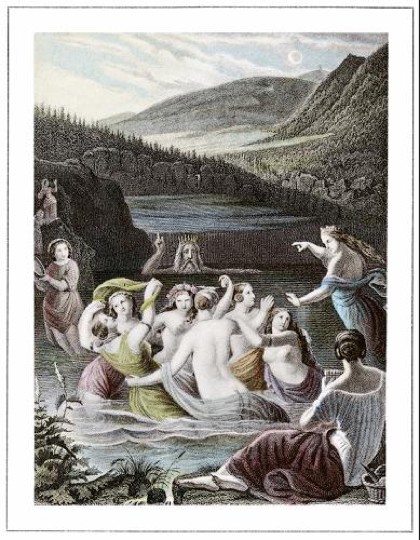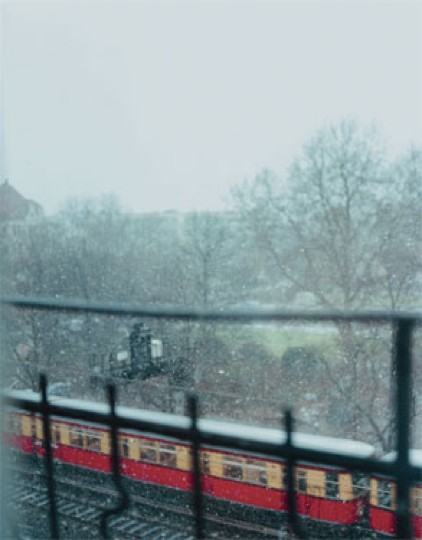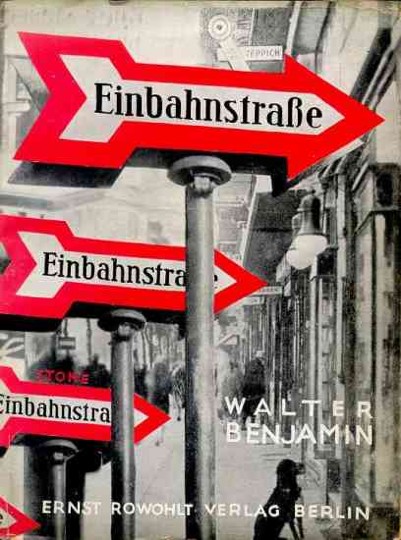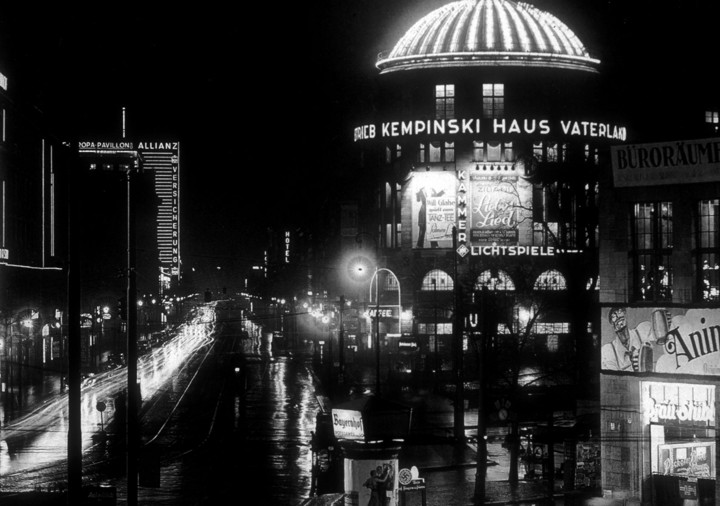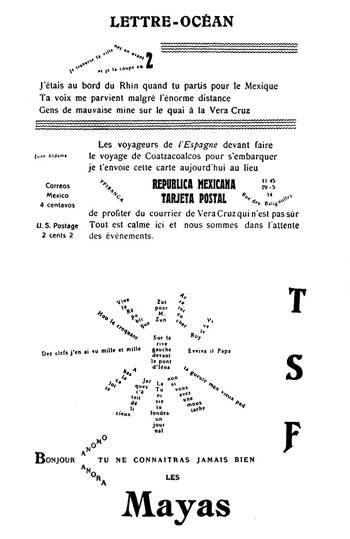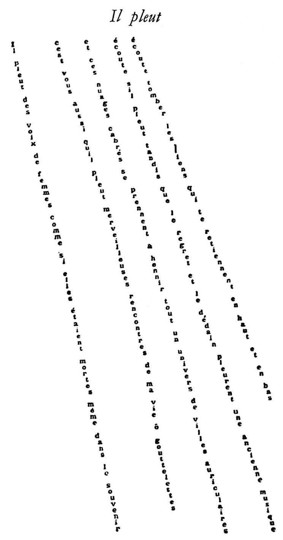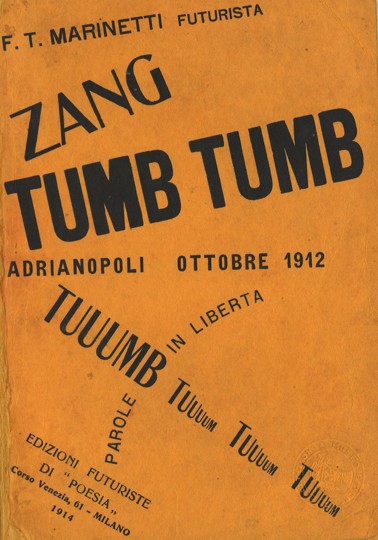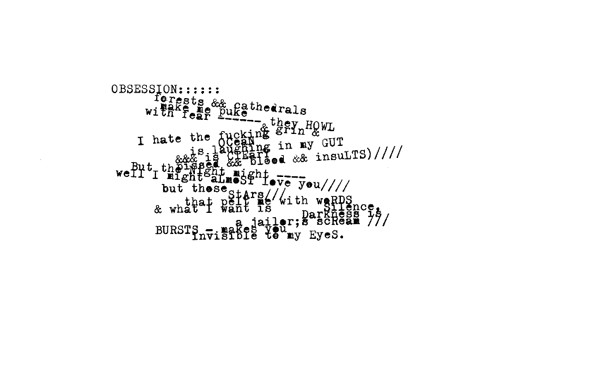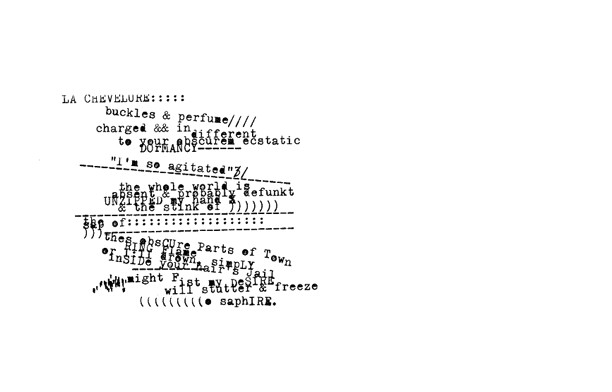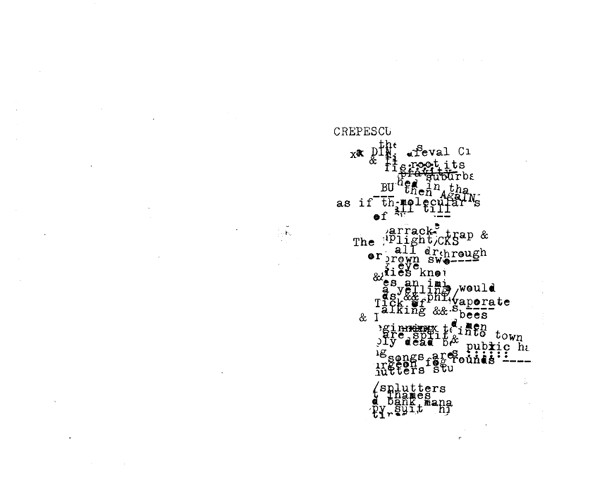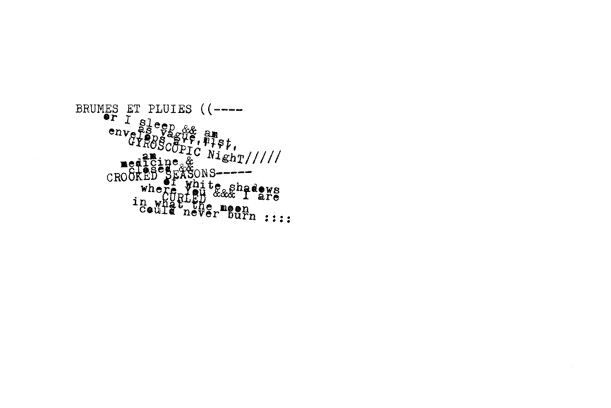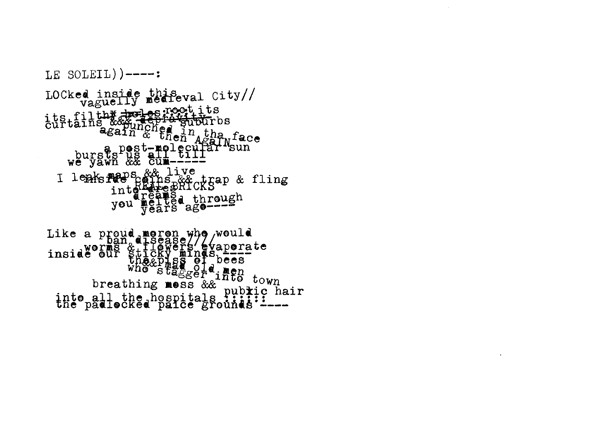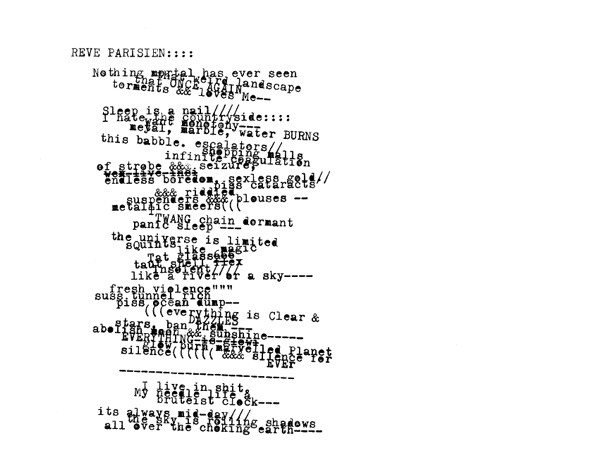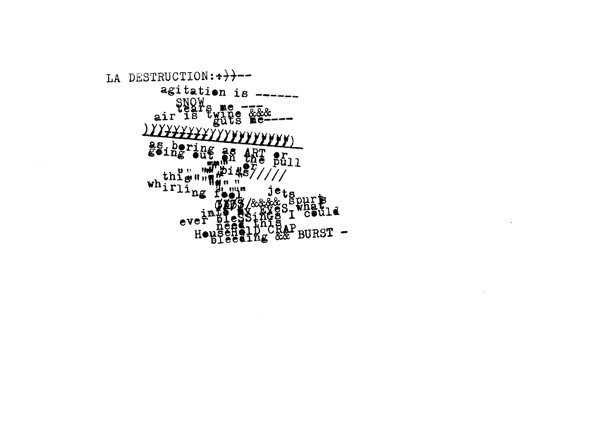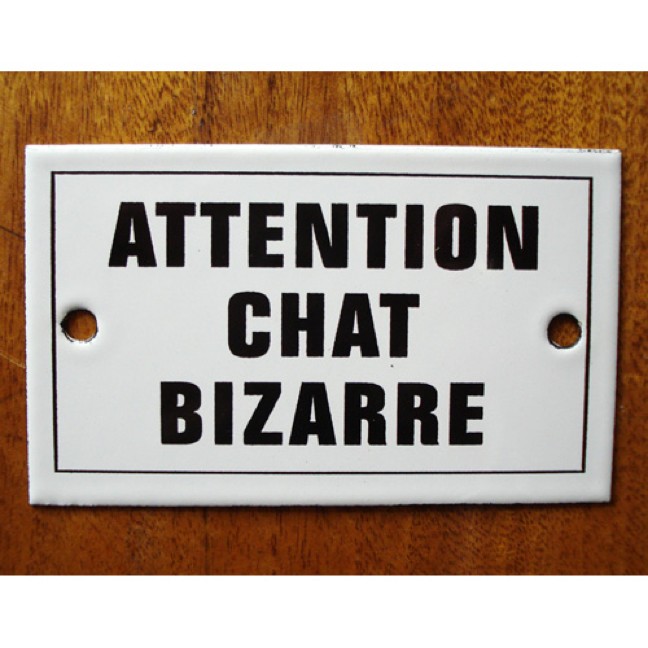A paper given at the Association of Art Historians Conference in Glasgow, 2010. The session, titled Reading to Attention, was organised by Sharon Kivland and Forbes Morlock.
WORDS RISE UP
Words rise up …. I came across this phrase in Baudelaire’s musings on intoxicated experience in 1860. Describing how, under the influence of something or other, even the tawdriest wallpaper in a pub turns into a magnificent diorama and the worst ceiling paintings will clothe themselves in life. The analogies of Fourier and the correspondences of Swedenbourg incarnate themselves ‘in all things vegetable and animal’ and the whole world turns allegorical. Under the ‘magic varnish’ of hashish, the following occurs, as Aleister Crowley’s translation from 1910 puts it: ‘all things; the universality of beings stands up before you with a new glory unsuspected until then. The grammar, the dry grammar itself, becomes something like a book of "barbarous names of evocation." The words rise up again, clothed with flesh and bone; the noun, in its solid majesty; the adjective's transparent robe which clothes and colours it with a shining web; and the verb, archangel of motion which sets swinging the phrase. Music, that other language dear to the idle or the profound souls who seek repose by varying their work, speaks to you of yourself, and recites to you the poem of your life; it incarnates in you, and you swoon away in it. It speaks your passion, not only in a vague, ill-defined manner, as it does in your careless evenings at the opera, but in a substantial and positive manner, each movement of the rhythm marking a movement understood of your soul, each note transforming itself into Word, and the whole poem entering into your brain like a dictionary endowed with life.’
A dictionary endowed with life – this Baudelaire imagined – or experienced – under the influence of drugs. Words rise into life. From spelt to spell.
Another instance of such an uprising, or reanimating of the word, the letter, of a poetics of the word let loose from grammar and dullness occurs a few years earlier in a different city. I take the anecdote from G.K. Chesterton’s study of Charles Dickens, as he describes Dickens’ ability to conjure up the ‘unbearable realism of a dream’. This is a realism that, he insists, ‘can only be gained by walking dreamily in a place’, and taking in its minute elements, but unconsciously. Such realism, notes Chesterton, ‘cannot be gained by walking observantly’, a ‘priggish habit’. Attention is not the attitude to be struck.
Chesterton elaborates:
'Dickens himself has given a perfect instance of how these nightmare minutiæ grew upon him in his trance of abstraction. He mentions among the coffee-shops into which he crept in those wretched days one in St. Martin's Lane, (quoting an unauthenticated autobiographical fragment from Dickens) "of which I only recollect it stood near the church, and that in the door there was an oval glass plate with 'COFFEE ROOM' painted on it, addressed towards the street. If I ever find myself in a very different kind of coffee-room now, but where there is an inscription on glass, and read it backwards on the wrong side, MOOR EEFFOC (as I often used to do then in a dismal reverie), a shock goes through my blood." (That wild word, "Moor Eeffoc" is the motto of all effective realism; it is the masterpiece of the good realistic principle -- the principle that the most fantastic thing of all is often the precise fact. And that elfish kind of realism Dickens adopted everywhere. His world was alive with inanimate object. The date on the door danced over Mr. Grewgious's, the knocker grinned at Mr. Scrooge, the Roman on the ceiling pointed down at Mr. Tulkinghorn, the elderly armchair leered at Tom Smart -- these are all moor eeffocish things. A man sees them because he does not look at them.'
It is this inattention that interests me – that through intoxication or reverie a more precise knowledge of what is, or at least, a more significant one returns to us. And when this language, these letters, freed of dry grammar or meaning, moves from something *spelt to something more like a spell.I want to justify this pun by extending it into German, to give it more credence, but also to take its punning action as symptomatic of this inattention-attention that I am trying to discern. There is a vignette in Walter Benjamin's memoir Berlin Childhood around 1900 called 'At the Corner of Steglitzer and Genthiner'. Benjamin conjures up a visit to an aunt. *He imagines this aunt as one of many silk-swaddled old ladies who never leave their homes, and yet like fairies they cast a spell across the street where they dwell, though they need never appear on it in person. Sorcery and the atmosphere of fairy tales pervade this anecdote with its protective and affable old maidservant, a steep farmhouse staircase in a posh Berlin apartment and a little old woman mysteriously tucked in the nucleus of this domicile, hoarding knowledge and secrets and treasures. His aunt's apartment is to be found at the place where two streets meet, and so her magical powers seem, to the child, redoubled. Magic is in the language, the very name of the street an incantation. In those days, Benjamin always transformed the name of the street from Steglitz – a town in Germany – to Stieglitz – the word for goldfinch.
Benjamin often mutated the words of his boyhood environment, and various anecdotes in his memoirs of childhood rely on this productive slipperiness of language. This is poetics for infants. In words’ transformation, and in their transformability lies their power. As such any word might be incantatory. Benjamin had long been interested in the idea of the word − or its smallest unit, the letter − as possessing a magical power. A footnote in his doctoral dissertation points out the Romantic connection between letters and magical powers. Schlegel writes to Novalis: 'the letter [Buchstab] is the true magic wand' [Zauberstab]. From spelling to spell.
I want to dwell for a while in the inept and attentively inattentive realm of children’s language. ‘Mummerehlen’ is Benjamin’s name for the transformation of things into a realm that is specific to the child. Muhme Rehlen – Old Mother Ehlen - was the name of a character in a fairy tale, but, because of its unfamiliarity to the child, because the child merges things, as is the child’s want, Muhme Rehlen melts into a single word mummerehlen. He writes:
'The misunderstanding disarranged the world for me. But in a good way: it lit up paths to the world’s interior.'
Mummerehlen: a meaningless word, but one that is also choc-a-bloc with significance, with resonance, with flurries of meanings at its heart. Mummen means to disguise. Mummelsee is a nymph-filled lake in the Black Forest, a watery realm that Benjamin thought might house the mummerehlen, its sluggish waters enveloping it like a grey cape. Mummerehlen is a word vessel for what Benjamin calls ‘the whole distorted world of childhood’. If it is his mishearing, it is in turn mute. He notes that the mummerehlen had almost no voice – ‘Its gaze spilled out from the irresolute flakes of the first snow’. He glimpsed this distorted world, but it never saw him. And yet he barely sees it, for as he tell us, in one version of the anecdote, it is a ghost. Or it is unlike itself, as he tells us elsewhere. For it is like a flurry of snowflakes or like a cloud.
'Mute, porous, flaky, it formed a cloud at the core of things, like the snow flurry in the little glass domes.'
For Benjamin, this wandering vagueness, this impression, that is the cloud, this shape-shifting form, this endlessly variable that is the clouds, the world seen through snow flurries, is the utopian actuality of the playing child. He writes:
'From time to time, I was whirled around in it. This would happen as I sat painting with watercolours. The colours I mixed would colour me. Even before I applied them to the drawing, I found myself disguised by them.'Wrapped in clouds or colours, disguised in language, language disguising itself in distortion. These are instances again of the inattentive attention, the exceeding that comes from looking askew.
It is this act of being swaddling or doused in a vagueness that becomes productive, which we could call poetics or other-thinking. The connections between this and reading are made explicit in another of Benjamin’s vignettes from his autobiographical writings Berlin Childhood around 1900. He writes:
'Sometimes in winter, standing in a warm room, at a window, the flakes of snow told silent stories to me, which I never quite grasped, for too thickly and unremittingly new things forced their way forward in amongst the familiar. Hardly had I intimately attached myself to one snowstorm, another one caught up within it, demanded submission.'
The gush of chaotic nature is unprocessable and overwhelming for the self. It cannot be grasped. He turns from the outside world to the world evoked inside the self, in books. It is an analogous experience – a flurry of letters like whirling snow crystals brings the chaos into line, into lines on the page, thus fixes it for reflection in imagination:
'But now the moment had come, in the flurry of letters, to chase the story, which had escaped me at the window. The distant lands I met here played together like the snowflakes. And because distance when it snows no longer travels into farness, but inside, so there lay Babylon and Bagdhad, Acco and Alaska, Tromso and Transvaal inside of me.'
The world of snow enters him. Benjamin encounters the world, but this time inside the smaller globe of his own head. He becomes the distance. Inside of him are the snow’s flurries. Inside of him has become a snow globe. He has become the world. Or at the very least he possesses a world for him. This connection between reading and snowfall had been made earlier by him, in One Way Street from the 1920s. Getting his hands on a long desired book, he gives himself up to the ‘soft drift of the text’, which ‘surrounded’ him as secretly, densely, and unceasingly as snow’. To the reading child, ‘the hero’s adventures can still be read in the swirling letters like figures and messages in drifting snowflakes’. The reading child’s breath is part of the air of the events narrated. He mingles with the characters, and ‘when he gets up, he is covered over and over by the snow of his reading’.
I think of these swirling words, flotsam of a dreamy Romanticism, as re-articulated in more modernist guise in Benjamin’s thoughts on literacy in the modern cityscape. As he puts it, in One Way Street, newly expelled from what he calls the bed-like sheets of a book, ‘a refuge in which script could lead an autonomous existence’ , words flicker across the night skyline, glimmering their neon messages above shops, or they stand upright on posters, newspapers or cinema screens.
'If centuries ago it began gradually to lie down, passing from the upright inscription to the manuscript resting on sloping desks before finally taking itself to bed in the printed book, it now begins just as slowly to rise again from the ground. The newspaper is read more in the vertical than in the horizontal plane, while film and advertisement force the printed word entirely into the dictatorial perpendicular.'
These vertical and sometimes moving scripts make the fixed and regular print in the book seem archaicly still. The urban dweller must be able to read such a cityscape − its signs, its words, its images, a ‘blizzard of changing, colourful, conflicting letters’. Script, he notes, ‘is pitilessly dragged out into the street by advertisements and subjected to the brutal heteronomies of economic chaos’. And it resonates with developments in art, where, since Mallarmé, the graphic nature of script is incorporated. Mallarmé predicted the future, Benjamin claims, incorporating in his 1897 poem ‘Un coup de dés’ all of ‘the graphic tensions of the advertisement’.
Apollinaire took this further in his Calligrammes in the second decade of the twentieth century with his ‘ideographic logic’ of spatial rather than narrative disposition.
And the Futurists clambered on board too, with Marinetti insisting on typographical revolutions, to express the disruption of syntax, metre, punctuation in pursuit of ‘lyrical intoxication’ in his efforts at abrupt instantaneous telegraphic communications.
I think today often of this swirling, chaotic writing, of writing screaming from billboards, moving vehicles, LED screens, as it has for so long – demanding and never finding really adequate enough attention. It may be that our reading, day to day, in the cityscape, is more like the traipse through the blizzard of words that jostle for our attention, while we absorb them more dreamily, inattentively. This might be the true struggle that is going on on the streets. But they seem currently to have the upper hand. If Benjamin saw them mobilise into uprightness, now they swarm, chasing us, catching up with us wherever we are in those little handheld gadgets that people carry. Beeping, squawking, demanding attention. A flurry of messages keeping us on message – on line – on a line, hooked, lined and sunk. Our attention is commanded. Reading to attention: the military connotations of this epithet – the reactive senses of this phrase, its demand.
Let me finish back where I started but in another way.
We are far from Baudelaire – I want to crash back into him. Sean Bonney, a London poet, found some Baudelaire poems. He rendered a brace of them into vicious verse. His versions are compressed, the translations not faithful in any strict linguistic sense. They tear at language, at the French they mockingly translate and at the English into which they are conveyed. English is the global language and here it splurts out in new, urgent and socially communicative rhythms, a world away from the lyrical subjectivism of Baudelaire. This is language damaged, language as damage, language as register of damage.
Compare Edna St. Vincent Millay and George Dillon’s 1936 version of ‘Reve parisien’and Bonney’s from 2008:
Hers:
I woke; my mind was bright with flame;
I saw the cheap and sordid hole
I live in, and my cares all came
Burrowing back into my soul.Brutally the twelve strokes of noon
Against my naked ear were hurled;
And a gray sky was drizzling down
Upon this sad, lethargic world.His:
I live in shit
MY needle life a
bruteist clock---
its always mid-day///
the sky is rolling shadows
all over the choking earth----The sentiment is degraded, from ‘cheap and sordid hole’ to ‘I live in shit’. ‘MY needle life’: drugs enter these homes as shitholes, drug dens, which then diverts the metaphor into that of the drugs wearing off and the cares returning to the soul, or rather the body. The motifs that are embedded in Baudelaire in chains of words are placed directly – so the distancing reference to time the chiming clock with its funereal accents becomes simply a clock. The cluttered and languid language of Baudelaire – deployed then as revolt against speed up, register of emergent temporalities – reduces to shock, the spluttered, paratactic mutterings of someone stranded after the new era, and hyped up on anger’s energy. The experience is extended – it is always mid-day – not a singular poetic glimpse, but a universal, and so more horrible, more trapped. And the earth is no longer this passive thing, this melancholic object of contemplation, a poetic object, rather it is choking. The earth, which is our body, chokes for us and with us. It is another version of the old pathetic fallacy, but it is one that figures in a contemporary imagination of ecological crisis, as greenhouses gases choke it and us and the boulevard gives way to escalators and shopping malls.
The visual format of Bonney’s Baudelaire poems is a part of their meaning. The lines trample over each other. They skew and clash on the page. Unpronounceable characters – brackets and commas, asterisks and carets – force their way in and some words are erased by typings over. The whole looks like a toppling pile of words, which cannot be easily read. This is a crucial part of an anti-writing, which means a denial of poetry’s complacency, just as Baudelaire in his day stretched lyric form to incorporate new contents and in so doing ruined, in a sense, poetry, in order to make it anew. Attention, attentiveness is lapsed. A certain textual violence rips up something that has sedimented into unquestioned value.
Bonney’s poems realise Mallarmé’s dreams for the future: graphic articulations, as nightmares, as excess signification in the landscape, the aural and oral pollution of official, political and commercial languages against which struggle the fragments of underdog speech to be heard. In life, Bonney declares poems through a megaphone at anti-war rallies. He chalks them on the ground. He performs them like someone spitting. One of Bonney’s poems from 2003 is an assault on language and its capacity to lie. Bonney took a speech by Tony Blair delivered in Glasgow on 15 February 2003 just as the second Gulf War began and shredded it literally, tearing and slashing the newspaper in which it was printed. The resulting poem defamiliarised language, exposing its politeness as vicious political violence. The words are mangled such that they can only be spat or shot out on the edge of comprehensibility, but traces of their ideological force, countered in an almost homeopathic act of debarbing, are still audible, if only because of the predictability of political rhetoric. Those political slogans returned precisely to their origin: 1513 is the first attested use of slogan - the ‘battle cry’, from the Gaelic sluagh-ghairm, the cry of a war-mongering horde
The graphic nature of Bonney’s poems impedes their easy reading, their untrammelled communicative ability, because their so obvious truths find it hard to make a passage into the world. It is as if all is turned backwards or on its head, in order to be all the truer. Their visual and graphic form suggests something splattered on the pavement, words that rose up in advertising and avant garde poetry smashed back down to the ground. Now you can stop paying attention.


